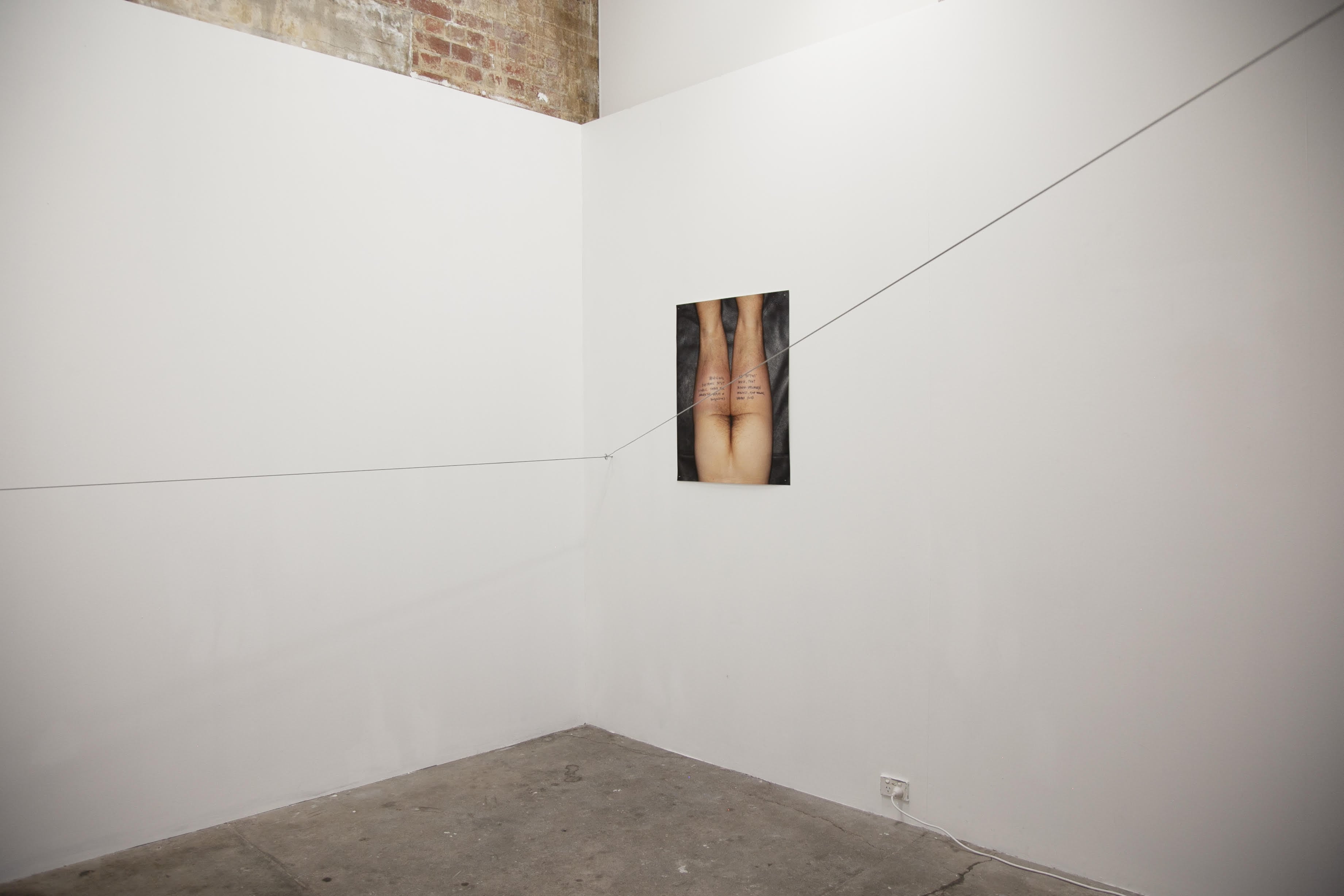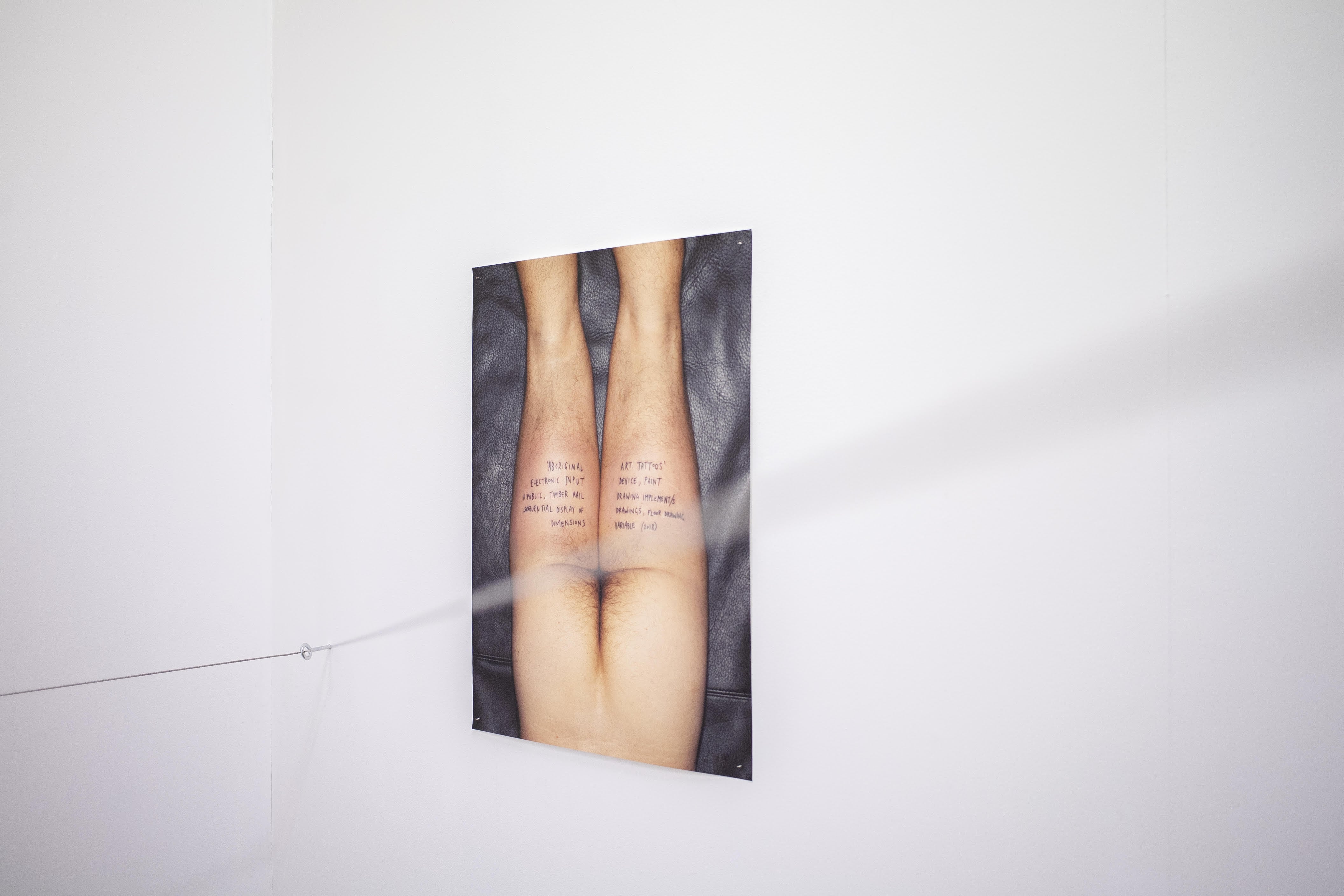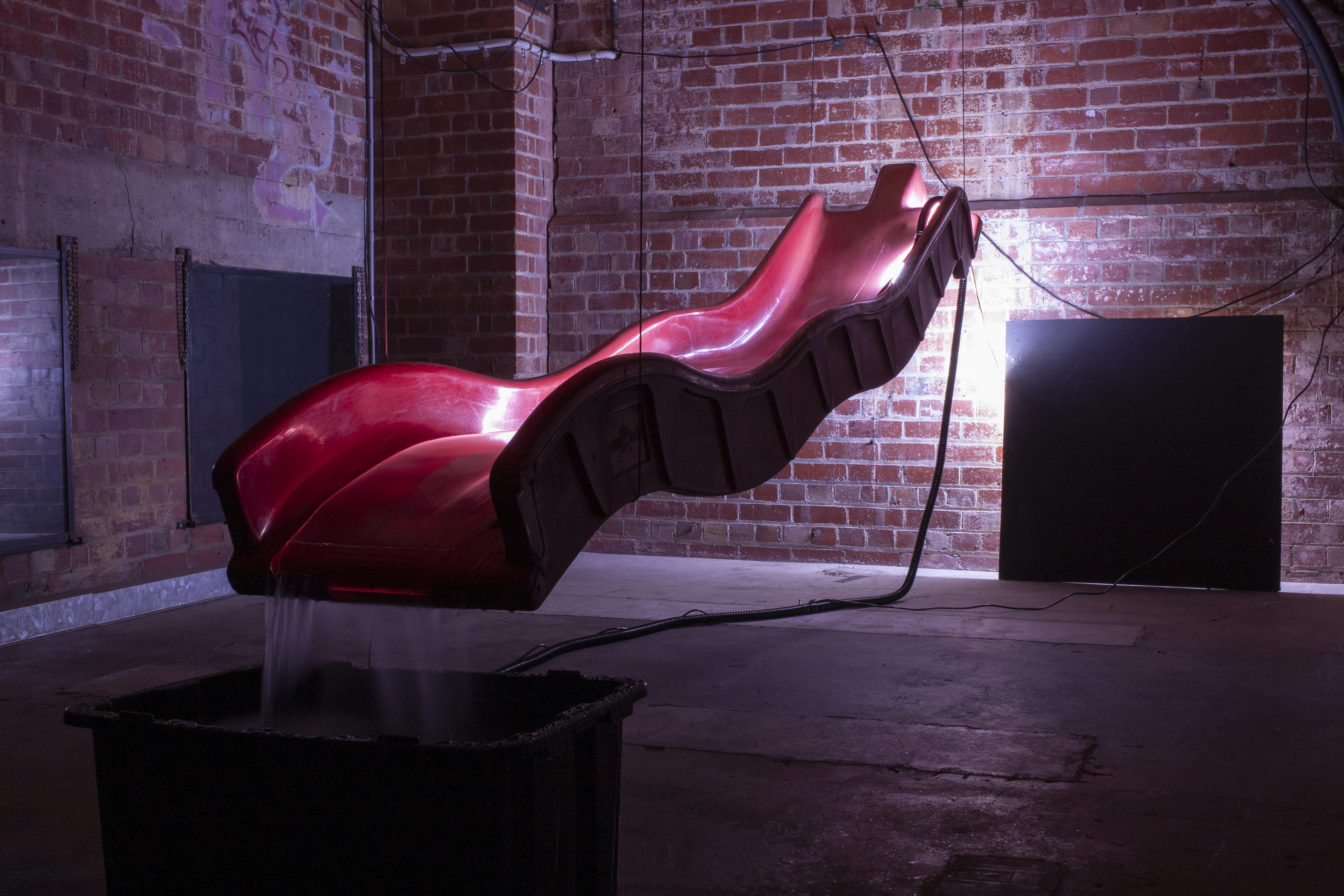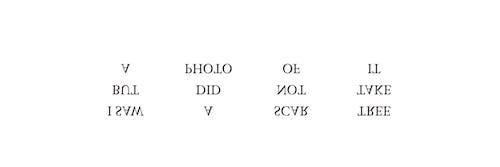




I heard a story on the radio the other day about a man who had had a medical device, a pump, implanted under his skin. After some time the pump broke and began beeping to indicate its malfunction. The device was not removed and the man lived with the beep beep beep for years. I usually think of medical technology as being absorbed, the alien object becomes a part of the body. But through its constant communication of error this device remained apart; the man could not assimilate the object.
Steven Rhall’s solo exhibition Defunctionalised Autonomous Objects occupies the entire ground floor of The Substation, a series of rooms splitting off from a wide hallway. The work is abundant and materially diverse: video, photography, sculpture, neon, found objects, tattoo flash, tattoo, interactive iPad with makeshift stylus fashioned from foam, wire and sticks. There is no room sheet, none of the works are titled and no material list is given. This is an exhibition as artwork; once inside I become part of the show’s material, too.
The first room off the main hallway is tight, made up of more corners than most. On one wall a screen is installed. A fixed shot: three studio walls housing a body hidden beneath a blanket, a chair, some bottles. On the screen, another screen displays a digital timer running up by the millisecond. Across the room is a horizontal rectangle cut into the plasterboard and edged with pine. An oversized peephole I have to crouch, I’m a creep, to look through. Inside is an installation within an installation: red and white neon text upside-down on a large rotating bollard reflected in a mirror (see left). Past the neon an identical peephole frames a letterbox view of a butt crack.
Beside me is a metal rod with medium gauge wire looped around its tip. The wire is taught, bending the rod in the direction of the peephole. It passes through the wall and, I think, travels out the other side. The strained rod threatens to snap back; is it a booby trap?1 A tripwire that will set off an alarm? beep beep beep
There is a sense of impending danger that accompanies the booby trap. A tentative fear of corporeal injury but, more so, of being the fool who makes the false move. Neika Lehman and Maddee Clark describe a similar feeling in relation to Rhall’s earlier work The Biggest Aboriginal Artwork in Melbourne Metro (2014) in their exhibition text Exhibition(ist) ‘I am hyper aware, looking distrustfully at my surroundings all the time.’ It’s an exciting feeling, that shit might blow, that I might blow it. In another darkened room the sound of running water draws me in, a sudden click, light and an explosion of air. A black air dancer with yellow eyes and downturned mouth springs into action; it’s arms flail, I catch my breath. My cover is blown.
The wire tracks me through the show, marking my line of sight, as if it knows in advance where I will look. In the room down the hall it leaves the wall, passes through a hook in the corner and leads out the door. The wire is instruction and imitation, just one of many moments in this show when the work anticipates and then turns to mimic the audience. It’s a combination I can’t put my finger on, something like algorithmic surveillance and a knowing laugh. CCTV cameras televise my looking in other rooms, framed by peepholes; my watching is watched. Is this a cliché; am I a cliché creep? An ambivalence^2 pervades the show – my vision is split, I’m pulled in two directions at once. Rhall uses ambivalence as method, drawing the audience into an awareness of their position as part of and apart from. The large SALE signs draped at the entrance, the framed print of a photographer photographing an Aboriginal man playing didgeridoo, the air dancer, the iPad with drawing software open and instruction scratched into the wall ‘MAKE YOUR OWN ABORIGINAL ART TATTOO OR NOT’ make clear that it is not only the exhibition that I am both part of and apart from.
The show’s title is lifted from Boris Groys’ essay ‘Politics of Installation’. In the essay Groys describes art making as a sovereign act in which the artist is free from the public’s demands for explanation or justification. Groys goes on: ‘The visitor is here, so to speak, on foreign ground, in exile. The visitor becomes an expatriate who must submit to a foreign law—one given to him or her by the artist. Here the artist acts as legislator, as a sovereign of the installation space.’3 Defunctionalised Autonomous Objects plays with Groys’ argument, here sovereignty is unmistakably marked by the colonial context and the whiteness of the art world. Inside the exhibition First Nations and settler visitors are subject to the law of his artistic sovereignty: ‘Defunctionalised Autonomous Objects is not contained by colonial (or counter-colonial) comprehension and Steven resists my easy interpretation.’
Reading Rhall’s catalogue essay (for which I had to choose to pay one of two prices: Privileged $35 or Other $15) it’s clear that Groys’ ideas about museological history, installation and the freedom of the artist, are fundamental to the artist’s thinking. Rhall does not adopt the Groysian framework wholesale but overlays it with the specificity of the colonial context. He pokes holes, pokes fun pokerfaced, at the art world’s attempts to contain his sovereignty. Down a short staircase, in the basement, a makeshift workshop is set up. Planks of wood, supported by breeze blocks are covered in a kitsch towel runner that depicts Aboriginal men with spears and plants in earthy colours. White microfibre suits are strewn across the floor and a pile of the styluses fashioned from twig, wire and foam are scattered across the low bench. This is funny. I laugh, just like Rhall knows I would.
I try to decide whether Defunctionalised Autonomous Objects implants the audience under the skin of the exhibition? To be in this body is not to be assimilated but to remain separate, alien below the epidermis. Or has Defunctionalised Autonomous Objects implanted an object under our skin? I leave and hear the beep beep beep in the days and weeks following. I have become aware of my position as viewer and viewed, marker and marked. This show slips through my fingers but remains under my skin.
Rosie Isaac is a Melbourne-based artist.
